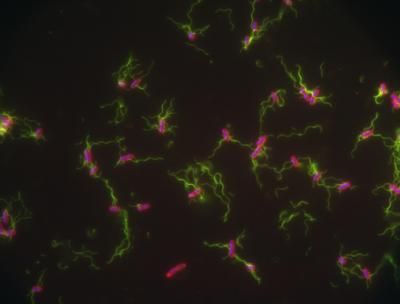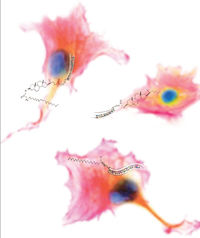Gene Therapy Converts Dead Bone Graft to New, Living Tissue
Researchers have created a way to transform the dead bone of a transplanted skeletal graft into living tissue in an experiment involving mice. The advance, which uses gene therapy to stimulate the body into treating the foreign splint as living bone, is a promising development for the thousands of cancer and trauma patients each year who suffer with fragile and failing bone grafts. The findings will appear in the March 1 issue of Nature medicine.
The procedure, designed by a team led by Edward M. Schwarz, Ph.D., associate professor of orthopedics and of microbiology and immunology at the University of Rochester Medical Center, is intended to eventually aid people with various cancers or injuries whose treatment involves the replacement of large sections of bone. Cancers such as osteosarcoma, one of the most common types of bone cancers, or tumors that occur adjacent to bones, often must be treated by removing the diseased section of bone and replacing it with the only alternative available - a donated section of comparable bone from a cadaver. The new splint of bone is then literally screwed into place, giving the patient most of the strength and support of the original bone. Bone, unlike any other tissue in the human body, can still perform one of its functions, structural support, even if all its cells are completely dead. A serious problem arises, however, when the bone wears over time.
"Everyday activities cause microscopic fractures in our bones," explains Schwarz. "Those fractures are normal and healthy, and our bones re-knit them constantly. But when the bone is dead, there is no healing, and those tiny fractures begin to accumulate until finally, perhaps in 10 years, the implanted section collapses, and more drastic surgery becomes necessary."
To make the transplanted bone more robust, Schwarz looked into the activity of the genes and proteins that govern its health. His team replaced sections of bones in dozens of mice, using both healthy and dead segments, then scanned the surrounding inflammatory tissue for differences in the levels of the active genes. He discovered that the genes that create two key proteins in living bone, called RANKL and VEGF, were barely expressed around the dead bone. He then modified a harmless virus to carry these genes, devised a method of freeze-drying a paste containing the virus so it could be easily handled, and painted it directly onto a bone graft during surgery.
Numerous tests in mice confirmed that the virus permeated the inflammatory tissue around the dead bone and turned on the genes. The mouse body then began to treat the implanted bone as if it were its own tissue instead of a foreign object, which would normally trigger the body to wrap the "invader" in scar tissue.
This process of teardown and rebuilding is triggered in the dead bone when Schwarz paints it with the genetically modified virus. New blood vessels begin to grow around and into the bone splint, stripping it down in times when the body needs the calcium, and rebuilding it when calcium levels rise. The bone that is rebuilt is now fully the patient's own, as if the dead bone were a house being renovated by replacing a single brick at a time without tearing the whole structure apart.
Schwarz's studies with mice showed their dead splints were quickly converted to new, healthy bone. He projects that the bone would be completely converted in just a year, and that a human bone might be completely converted in as little as five years.
Other scientists have attempted to invoke a similar reaction in dead bone by infusing tissue-growing proteins directly into the bone. This has proven successful for the small bone transplants used in spinal fusion, but not for larger grafts, because the proteins' effectiveness wear off in just hours.
Rochester-based biotechnology company LAGeT seeks to commercialize these research findings on light-activated gene therapy and has licensed the technology from the university.
Other news from the department research and development
Most read news
More news from our other portals
See the theme worlds for related content
Topic world Gene therapy
Genetic diseases once considered untreatable are now at the center of innovative therapeutic approaches. Research and development of gene therapies in biotech and pharma aim to directly correct or replace defective or missing genes to combat disease at the molecular level. This revolutionary approach promises not only to treat symptoms, but to eliminate the cause of the disease itself.

Topic world Gene therapy
Genetic diseases once considered untreatable are now at the center of innovative therapeutic approaches. Research and development of gene therapies in biotech and pharma aim to directly correct or replace defective or missing genes to combat disease at the molecular level. This revolutionary approach promises not only to treat symptoms, but to eliminate the cause of the disease itself.

























































